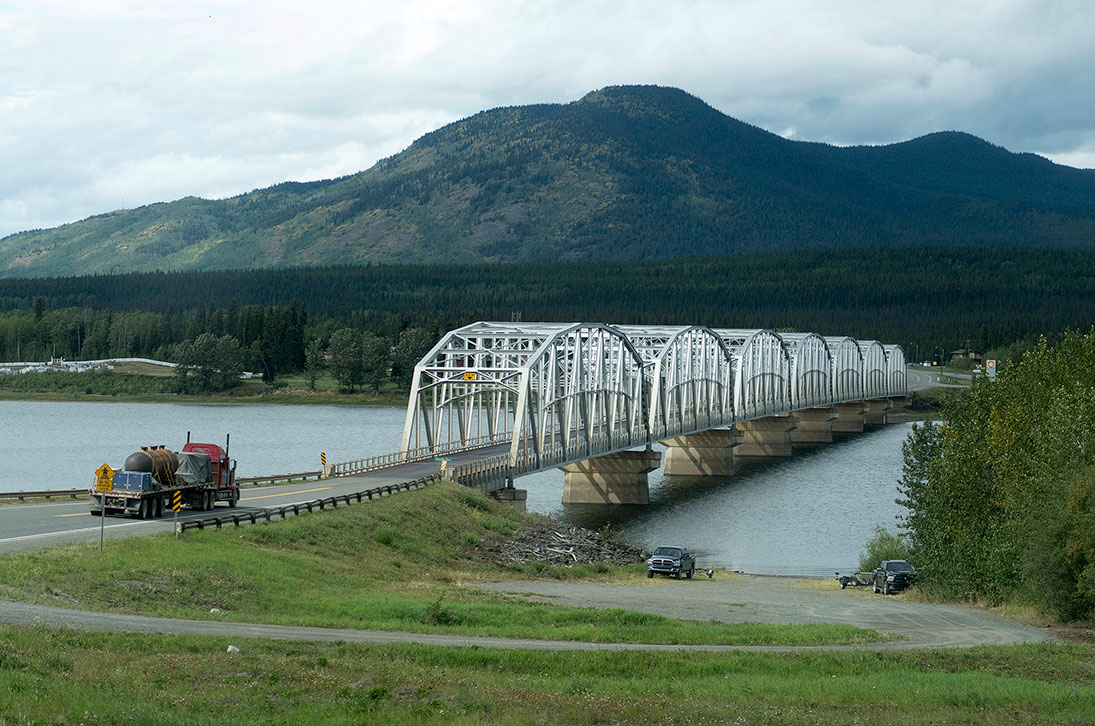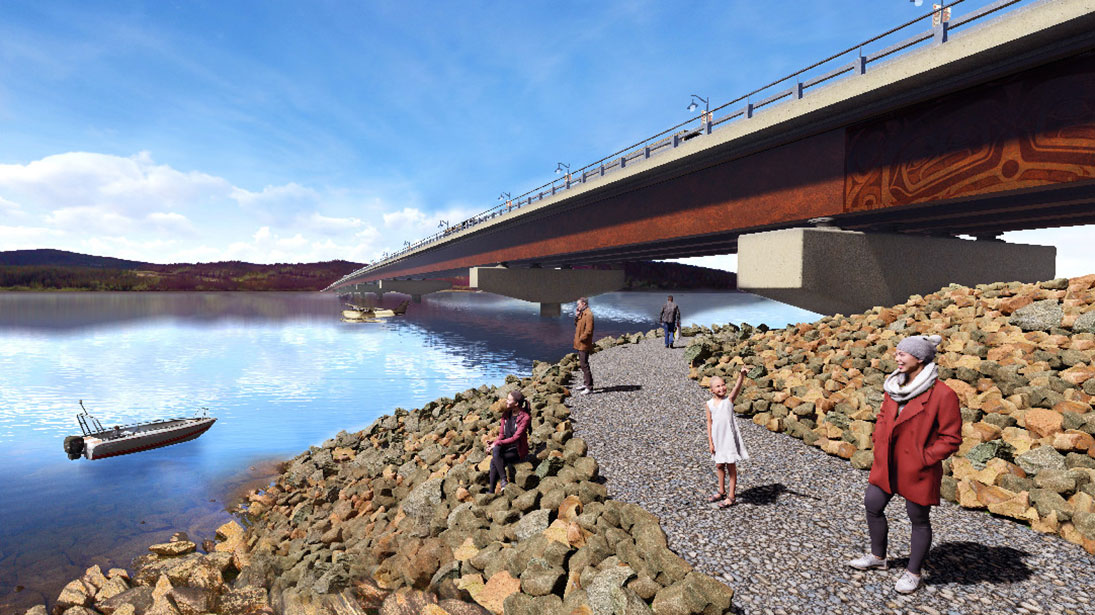
Photo by Whitehorse Star
GIVING WAY TO A SUCCESSOR – The Nisutlin Bay Bridge at Teslin is being replaced after serving the territory for 70 years.

Photo by Whitehorse Star
GIVING WAY TO A SUCCESSOR – The Nisutlin Bay Bridge at Teslin is being replaced after serving the territory for 70 years.

Photo by Photo Submitted
Following a delay with licensing, the Nisutlin Bay Bridge will not be completed until 2025-26, nearly 12 years after the project was introduced by the former Yukon Party government, Highways and Public Works Minister Nils Clarke said Wednesday.
Following a delay with licensing, the Nisutlin Bay Bridge will not be completed until 2025-26, nearly 12 years after the project was introduced by the former Yukon Party government, Highways and Public Works Minister Nils Clarke said Wednesday.
Worth more than $160 million, the new bridge is the largest infrastructure project in the history of the Yukon, and is an important part of the territory’s framework connecting the South with the Yukon.
“The new bridge will be safer for pedestrians and cyclists and allow for increases in traffic, as you’ve heard at various times both last fall and in the spring,” Clarke to reporters.
“This is so far the biggest infrastructure project that has ever been engaged in Yukon history.”
The government awarded the $160-million contract on May 3, 2022 to Graham Infrastructure LP.
The project was set to begin in the summer of 2022.
But at the time, the government had yet to obtain a federal Department of Fisheries and Oceans (DFO) authorization, which it eventually received on Oct. 17/18, 2022.
“We’ve heard from First Nations across the Yukon about what a devastating impact the low salmon numbers have been for them and their communities,” NDP MLA Lane Tredger told reporters.
“The Teslin Tlingit had a dramatically altered relationship with salmon for a generation now because of the low low numbers. So the fact that they didn’t have all the protections they needed in place before they went ahead with the project tender is really concerning.”
DFO sets out the rules for what can be done around fish-bearing bodies of water.
When the authorization arrived, it had new conditions for the project – which have shifted the work plan, causing delays and increased costs.
“The government did not have the Fisheries Act authorization until almost six months after the awarding of the contract. The note also reveals that they did not have a water licence until late August,” Yukon Party MLA Stacey Hassard told the House on Wednesday.
The water licence for the project was issued Aug. 31, 2022.
“The authorization created substantial new conditions on the project, which has shifted the work plan,” said Hassard.
“The minister’s own briefing notes acknowledge this. Here is what the note said in October 2022 — and I quote: ‘The department is working with the contractor to assess and potentially adjust the work plan based on Fisheries Act authorization conditions.’”
In the House, Clarke indicated that project work for the 2023 construction season started on March 16 and will continue through the spring and summer.
As of now, Graham Infrastructure LP has completed mobilization, site preparation, construction camp and project office set up, initial pit and quarry development for granular and rock production, partial temporary works such as trestle bridge construction, which includes piling and building access ramps, civil works such as clearing and grubbing of the new alignment, and fish salvage work.
According to a briefing note, the contractor plans to work on temporary and permanent works such as piling, cofferdam and complete access road/ ramp and granular and rock production this spring.
The department had also worked with the contractor and Teslin Tlingit Council on an application for an amendment and a variance to the Fisheries Act authorization to help streamline the work plan.
An amendment was received on Feb. 24 and the variance on March 8.
The Yukon government says the new authorization will allow the work to proceed.
Due to the delays and setbacks with the Fisheries Act process, the project is expected to exceed the original budget of $160 million.
Clarke told reporters that to make budget allocation decisions, it’s about “shifting priorities.
“There’s an envelope of funding that’s open to this cabinet and to Highways and Public Works to make budget allocation decisions on again, shifting priorities.
“There are a lot of moving parts. I know that, but we will get this done.
“The five-year capital plan includes $110 to $125 million, Yukon Party Leader Currie Dixon told reporters.
“We know that the contract alone is $160 million. And that’s before any increases, so there’s already a funding gap.
“We understand the conditions that they put on through the Fisheries Act authorization is much different than what Graham had anticipated in their bid,” Dixon said.
“It’s significantly shortened the amount of time they have to do certain types of work, in particular, while driving. And that created a significant change to the work plan.”
Now the work plan for the project is much longer than anticipated, which means the costs are going up, Dixon added.
“And so while we don’t know the number of change orders or the cost increases, we know that they’re coming, and so there’s certainly going to be a higher number than $160 million.”
Clarke said discussions are ongoing with Graham Infrastructure.
“I have had opportunities to meet with the management of Graham Infrastructure LP in Teslin on a few occasions and have been impressed by their can-do attitude,” Clarke said in the House.
“Their employees have advised that they are problem-solvers and that they accept and embrace this project.
“As I said previously, there are a lot of moving parts with respect to this project and, over the course of the next 3 1/2 years, it is possible that there will be some additional costs.”
The Yukon Party remains concerned that the federal budget tabled March 28 included no new funding for Yukon infrastructure.
“We understand from the minister’s briefing note that they’ve applied to the feds for additional funding, but I didn’t see any funding for it in the federal budget,” Dixon said.
“And we haven’t heard from the minister today about whether any additional funding has been secured. So there’s some significant questions about the timeline in the budget for this project,” said Dixon.
“The federal budget included no extension of ICIP (Investing in Canada Infrastructure Program) and no announcement of the replacement price. So we don’t know what’s going to come for future infrastructure programs.”
Yukon Party MLA Scott Kent said a few weeks ago the government had applied for additional funds, but they barely cover the funding gap.
“Just a few weeks ago, the minister told the legislature that they had applied for another $52.5 million from Transport Canada, but that barely covers the existing funding gap, let alone the cost increases that the minister has said are yet to come,” Kent said.
“So, how much more does the minister think the Yukon government needs to budget to ensure that there are sufficient funds to complete the Nisutlin Bay Bridge?”
Premier Ranj Pillai said the federal budget talked about the reallocation of ICIP money throughout Canada.
“It talked about how regions — as our interpretation — that have fully used their ICIP funding have the opportunity to again have access to funds that haven’t been used across the country,” he said.
“I think it is important that we still have the opportunity to continue to invest in infrastructure across the territory. Again, we were happy to see that,” said Pillai.
“We have also worked with the federal government around flexibility within our ICIP funding. That is something that all three northern premiers have worked toward; we think that is a possibility.
“Again, it is really about maximizing the use of those funds. It is about investing in infrastructure.”
According to a session briefing note obtained by the Star dated fall 2022, maintenance costs of the existing bridge are between $500,000 and $1 million per year.
The structure is nearing the end of its life after 70 years.
The new bridge is being built right beside the existing one and will have a predicted lifespan of 100 years.
“When a project of this size sees delays that impacts our public finances, it impacts our ability to fund other projects, and then impacts our ability to afford other priorities,” Dixon pointed out.
“And so if we have to borrow more money, or if we have to seek funding from other sources, that’s going to impact our ability to focus on other priorities as well.
“But ultimately, we’re concerned about the management of this project. It’s the biggest one, the biggest capital project in Yukon history, and they should be taking it seriously,” Dixon said.
In order to encourage thoughtful and responsible discussion, website comments will not be visible until a moderator approves them. Please add comments judiciously and refrain from maligning any individual or institution. Read about our user comment and privacy policies.
Your name and email address are required before your comment is posted. Otherwise, your comment will not be posted.
Be the first to comment